
|
|

April 29, 2005
WOR, 1440 Broadway: End of an Era
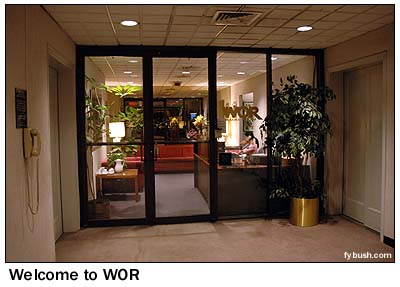 In
today's era of cookie-cutter cluster studios in suburban office
parks, it's getting rare to find a radio station that's still
at the same address it called home a decade or two ago.
In
today's era of cookie-cutter cluster studios in suburban office
parks, it's getting rare to find a radio station that's still
at the same address it called home a decade or two ago.
We pause, then, to pay homage to what may well be the longest association between a commercial radio station and a single address in history: WOR, 1440 Broadway, New York.
In 1928, Bamberger's department store installed a Manhattan studio for what was then WOR, Newark in that Times Square office building. A few years later, "1440" became the sole studio location for WOR, and over the years, that's where WOR remained.
As the decades went by, things changed. WOR-FM moved in in the forties, moved to its own quarters on the second floor in the sixties, became WXLO and then WRKS, and then moved out in the eighties. WOR-TV (Channel 9) ended up here as well after a circuitous path that took it from a transmitter on the Palisades in New Jersey to an overly costly studio facility at Broadway and 67th Street to a control room at Empire State Building. WOR (710) itself moved around within the building, operating on the 24th floor and then moving, in 1976, to a suite of offices that filled the 23rd floor and extended down to 22, where the WOR Radio Network's offices were to be found.
And on April 30, 2005 at noon, WOR will make its last broadcast from 1440 Broadway before the station completes its move to new quarters at 111 Broadway, down near Wall Street.
Fortunately, your intrepid photographer has had several opportunities over the last few years to visit WOR at 1440, thanks to the kindness of Buckley Broadcasting director of engineering Tom Ray and WOR chief engineer Kerry Richards, and so this week we dedicate Site of the Week to a profile of this most historic site in broadcasting history. Come inside, take a left past the reception desk, pass the men's room (did you know that it was a much earlier WOR men's room, circa 1927, that functioned as the very first control room for what would become the CBS Radio Network?), turn right past the engineering offices and down the hall full of historic photos, and let's go:
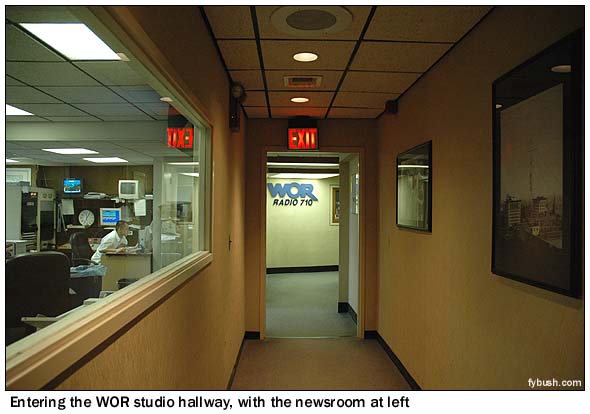
As we round the corner (we're actually circling the air shaft down the middle of this old building), we see on the right some of the historic photos that will soon be moving to 111 Broadway, including that neat one of the WOR antenna mast atop Bamberger's in Newark. There are also photos of an early WOR transmitter in Kearney, N.J. and of Jack Poppele, the legendary engineer who spent so many decades innovating at WOR. On our left is the newsroom, and just beyond it a small studio ("Studio 5") that's used for production.
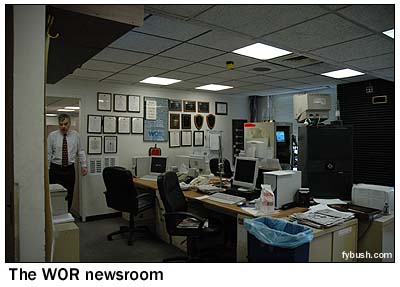
|
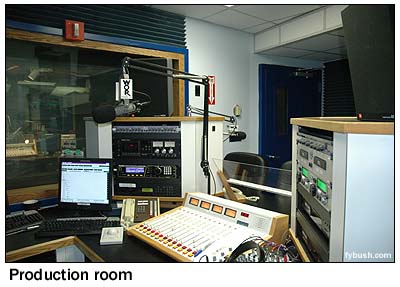
|
From here, we round the corner past that "WOR Radio 710" sign, and we're now on the main hallway of studios, which run along the Broadway side of the building, 23 stories above Times Square, and along the other side of the hall as well, facing out on the air shaft.
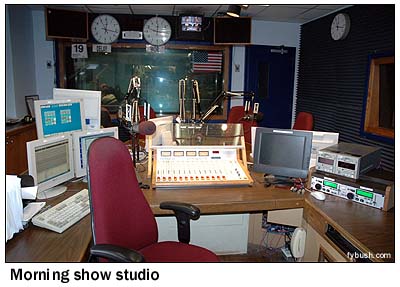
|
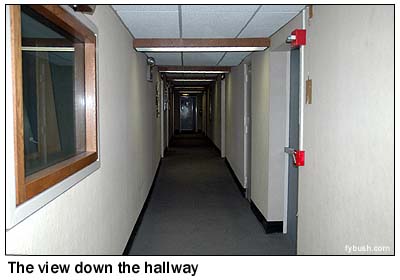
|
The window on the right in the picture at left is the very same window on the left in the picture at right, and the studio into which it looks, Studio 2, is used for much of WOR's local talk - Ed Walsh in the morning (those CD players on the right side of the desk allow him to play his music) and Bob Grant in the afternoon. That's ENCO automation running on the screens at left, and that door looks into a control room (Control 2, of course) that then leads into the station's master control, about halfway down the hallway.
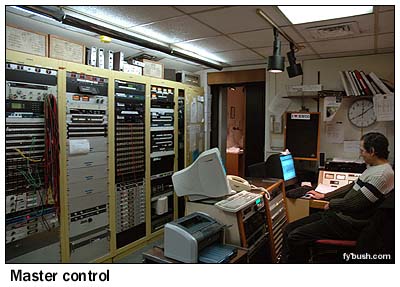
|
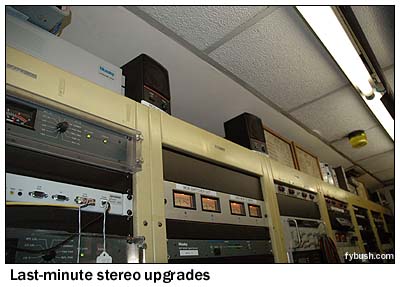 |
This is one crowded little room, dominated by a long row of racks full of patch bays, STL gear (it's a nice clean microwave shot from here across the Hudson to the Lyndhurst, N.J. transmitter site), satellite receivers, processing and so on.
And it's become an even more crowded room in recent years, as Tom and Kerry have modified WOR to become one of the first IBOC digital AM stations - and, just months before vacating these studios, to produce all its programming in stereo. That's meant everything from a new top-of-the-hour time tone to rewiring the consoles throughout the plant to pass stereo - and it sounds pretty good, too, on the IBOC (er, HD Radio) monitors that have now been installed in these racks.
On the left, we see some of the last additions that were ever made to the 1440 Broadway plant, including stereo meters and monitors and an upgraded STL. Just out of frame is the HD Radio off-air monitor, a car radio installed in a rack-mount panel. (It replaced one of Ibiquity's very first pre-production, homebrew tuners, which filled something like six inches of rack space all by itself.)
A final note about these racks: an inventory tag on the back of one is apparently the last place you'll see the old "WXLO-FM" calls anywhere in this building.
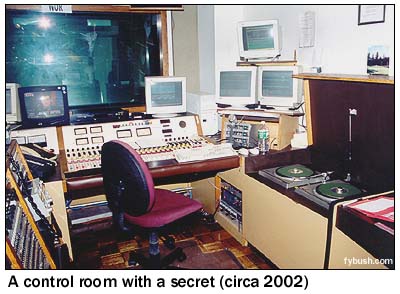
|
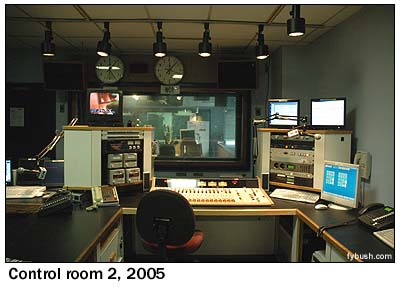 |
Master control is flanked by two control room/studio pairs. To the left as you face Broadway is the aforementioned control 2/studio 2. Those turntables hiding under the furniture in the 2002 picture were used by Joe Franklin for his old-time music and chat show that was a weekend staple on WOR until just a year or so ago; in the more current photo, we're looking at the same room as it was recently rebuilt. The rebuild not only freshened up this aging room; it also freed up parts from that old Pacific Recorders console to allow Kerry to rebuild control room 1, on the other side of master control, for stereo operation. (After 25 years with no right channel, Kerry reinstalled the missing parts to make it a two-channel board again.)
Beyond control room 1 is yet another studio, studio 1, that's used for network talker Lionel and for local talkers Joan Hamburg and Rocco DiSpirito. And beyond that is the end of the hallway, where we cross to the other side and peek in on studio 4, which was used primarily for pre-producing talk shows for the WOR network. (There's also a small booth attached to that that can be used for voice work and other light duty.)
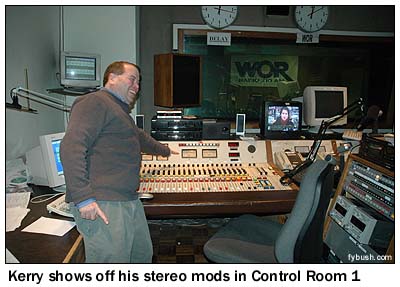
|
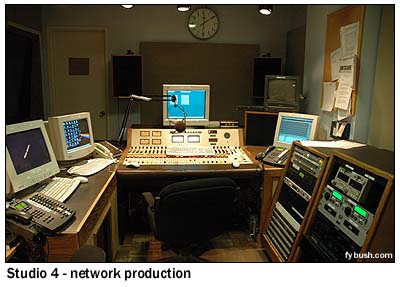 |
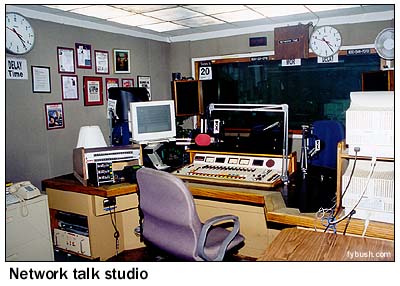 Next
to studio 4, across the hall from master control, is a large
studio (studio 3) and adjoining control room from which much
of WOR's network talk programming - Dr. Joy Browne, for instance
- emanates. These rooms are especially well soundproofed, in
the fashion of the mid-seventies, with big heavy doors and floating
walls and floors.
Next
to studio 4, across the hall from master control, is a large
studio (studio 3) and adjoining control room from which much
of WOR's network talk programming - Dr. Joy Browne, for instance
- emanates. These rooms are especially well soundproofed, in
the fashion of the mid-seventies, with big heavy doors and floating
walls and floors.
The rest of the facility - what you'd see if you turned right, instead of left, when passing through the lobby - is all sales and business offices. Or rather, "was" all sales and business offices, as those moved downtown before the studios did.
And so we come to the end of our tour, and the end of 77 years of history at 1440 Broadway. Soon enough, we'll get downtown to see the new digs (and share them with you.) In the meantime, Tom and Kerry are still awfully busy folks: they've also got a transmitter site move to deal with. Next week, we'll show you the site in Lyndhurst that WOR has called home since 1967...
It's here - the 2005 Tower Site Calendar is now available at special clearance prices! Click here for ordering information!
- Previous Site of the Week: WPIC, Sharon PA
- Next Week: WOR transmitter, Lyndhurst NJ
- Site of the Week INDEX!
- How can you help support Site of the Week? Click here!
- Submit your suggestions for a future Site of the Week!
